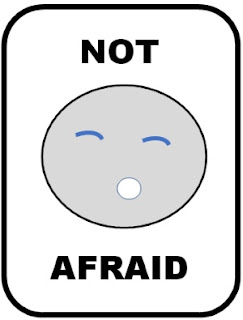I'm afraid. . .
-- Anna (from The King and I)
“What are you going
to do?” she asked.
“I’m going for a
run,” I answered. She laughed, so I went over to see what this was about.
“We thought you
were going over there to calm things down,” she told me.
I listened for a
moment, and realized what she was talking about. A couple down the street was
having a loud argument, well-peppered with vulgarities, and was sharing it via
the open windows.
This was a private neighborhood and I was the association president. There was reason for my neighbor’s curiosity – she thought I was out to exercise whatever authority I might have to restore peace, or at least quiet.
That had not been
my intent before I knew of the disruption, nor was it after she clued me in.
The racket subsided on its own, but the misidentification of my
intentions reinforces something for me: the important role of body language.
How people read our
actions and expressions determines how we relate to each other. I think we do
it – mostly unconsciously -- all the time, and have been doing it since we were
little kids.
On the night this
happened, I had barely a thought in my head as I went out on what I considered
a simply physical solo process. Mindless. Innocent.
My neighbor saw something
much different: the association president heading purposefully toward a
heated situation that could get messy.
She read the vigor of my gait as an expression of authoritative intent, not a
warmup for a trot.
We chuckled about
that gulf between perception and reality. But an important point can be drawn
from it.
How many times have
we misidentified a person’s attitude and/or intentions because of the way we
interpreted the person’s facial expression or body movements?
How often has such
an error triggered an angry exchange
or produced an enduring conclusion that permanently damaged a positive
relationship?
Anna’s second verse is about the second
important value of whistling away one’s fears:
The result of this
deception
Is very strange to
tell
For when I fool the
people
I fear I fool myself
as well!
The way I was walking that evening was not
intentionally assertive. . . .Or was it?
Maybe the energy was directed to myself – to get me going on the physical
routine.
If it was, it was
an illustration of outside-in behavior modification. The idea is that if you
discipline yourself to do something frequently enough and long enough, it will
become a habit without further attention from you.
Getting in the mood
for a successful jog is not a major example of the practice, but in the
neighborhood situation its external effect was strong enough to create my
neighbor’s harmless misperception.
It’s important to
specify that her conclusion resulted from her frame of reference, one that was worlds
away from the actual motive that determined my behavior.
We need to pay attention to this, because
it’s going on all the time, all around us.
Start with this: The way
we walk has a lot to do with our success in life. Our stride is vigorous. Or assertive. Or uncertain.
Likewise the way we
talk. And how carefully we listen.
The way we sit.
And the looks on our
faces.
And how we act at
meetings.
People see all that, each person from his/her own viewpoint. Our actions are external
displays of our inner attitudes. We don’t control the other end of the
communication transaction.
Do people feel
constrained to look up and say, “Hi!” as you go by in the morning? Do they even
know you’re there? Do they care?
If the answers are
“yes,” then you matter.
There is no way the actor and the viewer can
have reasonably accurate understandings of each other’s frame of reference . .
. without help.
There are two ways
each party can build a better understanding
of what’s really going on over on the other side, and maybe influence it:
Ask questions to validate or repair first
impressions.
Modify one’s own behavior to send clear
signals.
We want to matter. Our effectiveness,
job satisfaction, our overall happiness depend upon our sense of self-worth.
That requires us to take responsibility for acting in ways that support and
advance a favorable place in our own estimation as well as that of our
associates.
In most situations
on the job, but especially in project work where people don’t know each other
very well, we need to build the habit of stopping, thinking and asking. No
impulsive leaps of word or action triggered by culture, surprise or annoyance.
More
constructively, we should build our behavior habits on this understanding.
So I’d walk with
chin up and shoulders back, making eye contact as I go along, greeting people and
responding with a pleasant voice. I’d sit up straight, pay attention and
contribute, even at boring meetings. People would come to expect ever-greater
quality from my presence.
I start by building
the attitude for success. I tell myself I matter. Frequently. I treat those
around me as if they matter, too. I make sure my manner shows those attitudes.
I probably couldn’t
get away with whistling happy tunes at tough moments, but I won’t have to.
TRY: A brighter smile and greeting one of these sleepy mornings, plus a positive comment. Any effect? Positive? Negative? Report in as a comment below.
TRY: A brighter smile and greeting one of these sleepy mornings, plus a positive comment. Any effect? Positive? Negative? Report in as a comment below.
SEE ALSO:
Up & Down the Pyramid
http://jimmillikenproject.blogspot.com/2011/05/up-down-pyramid.html


No comments:
Post a Comment